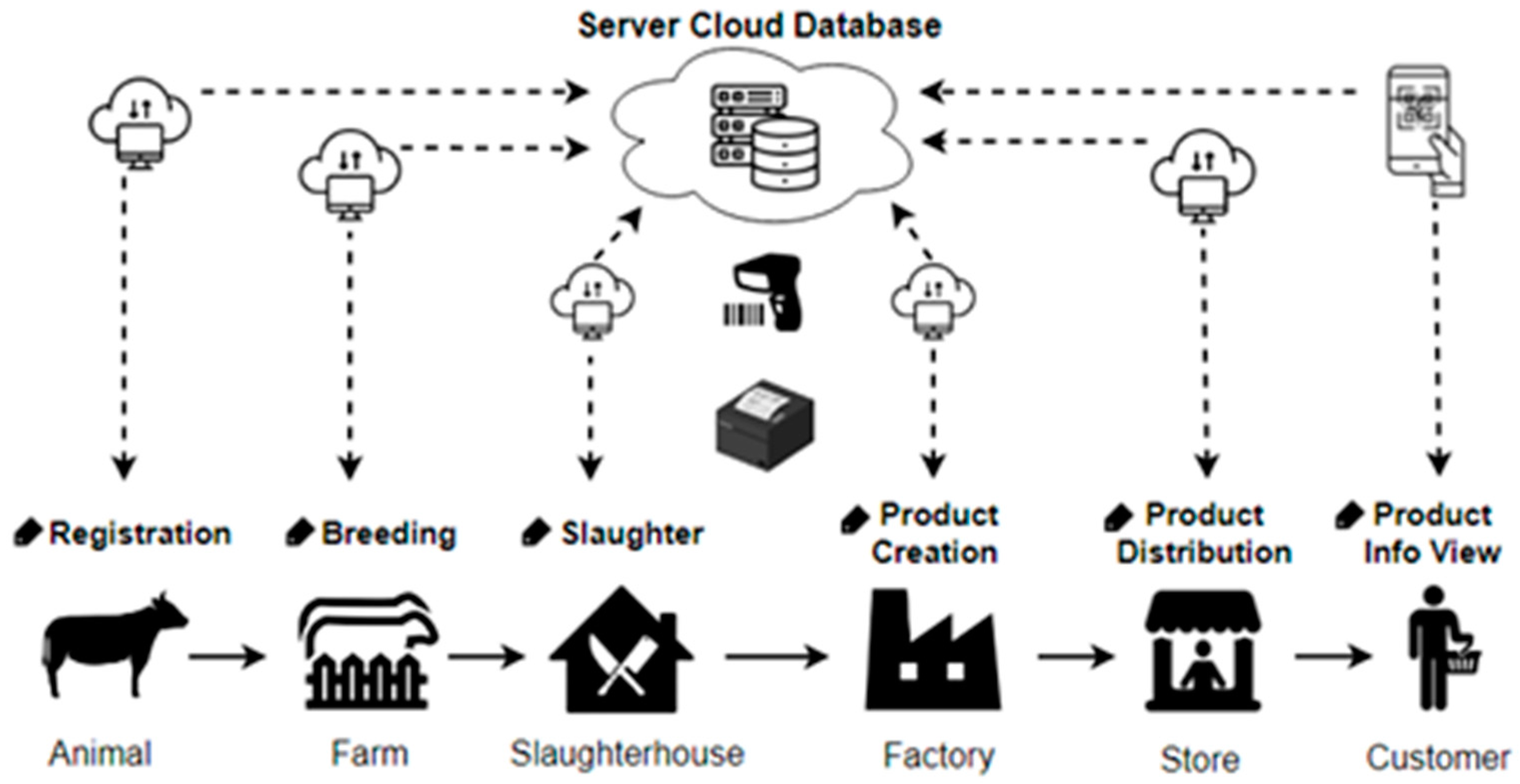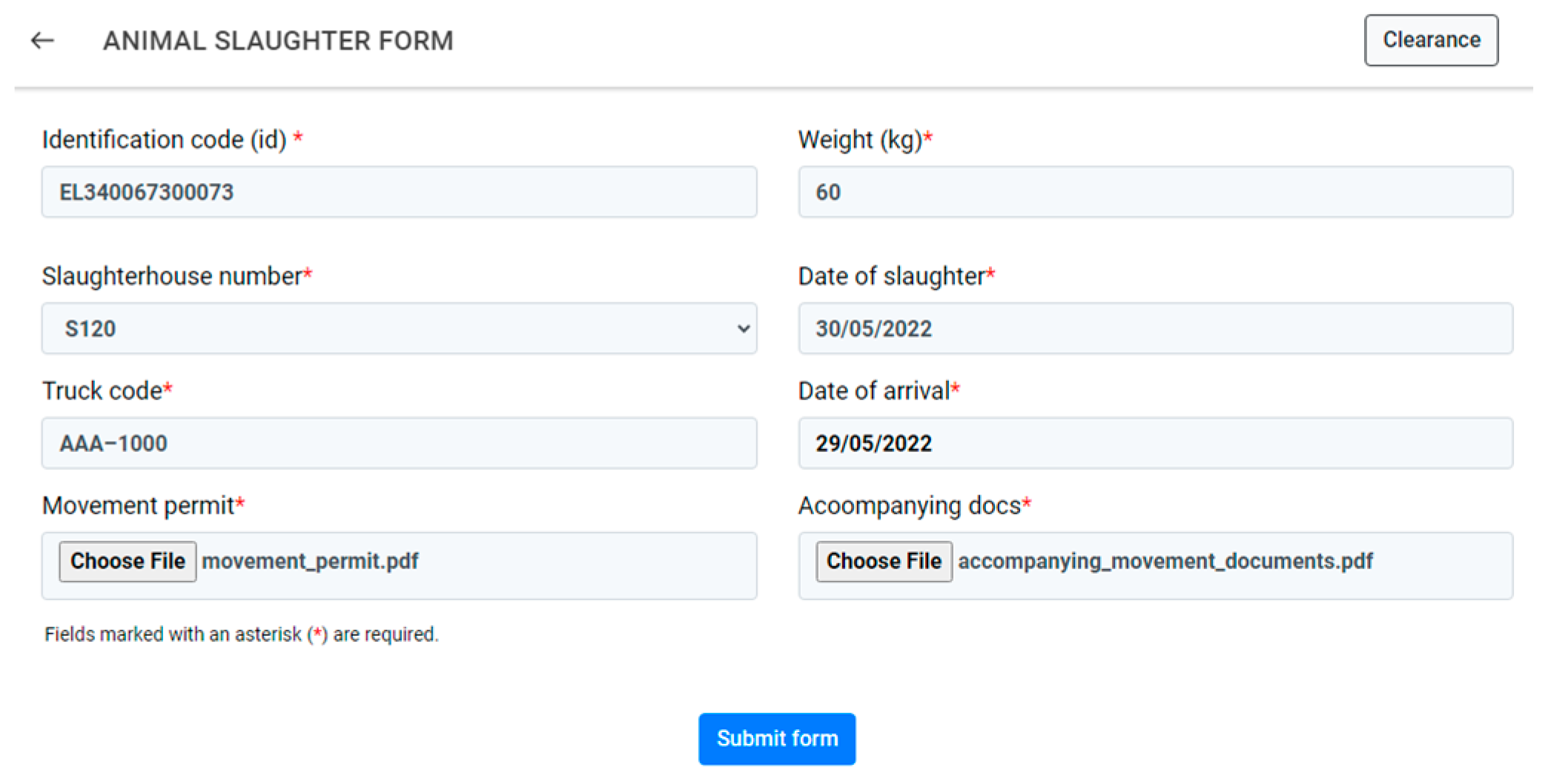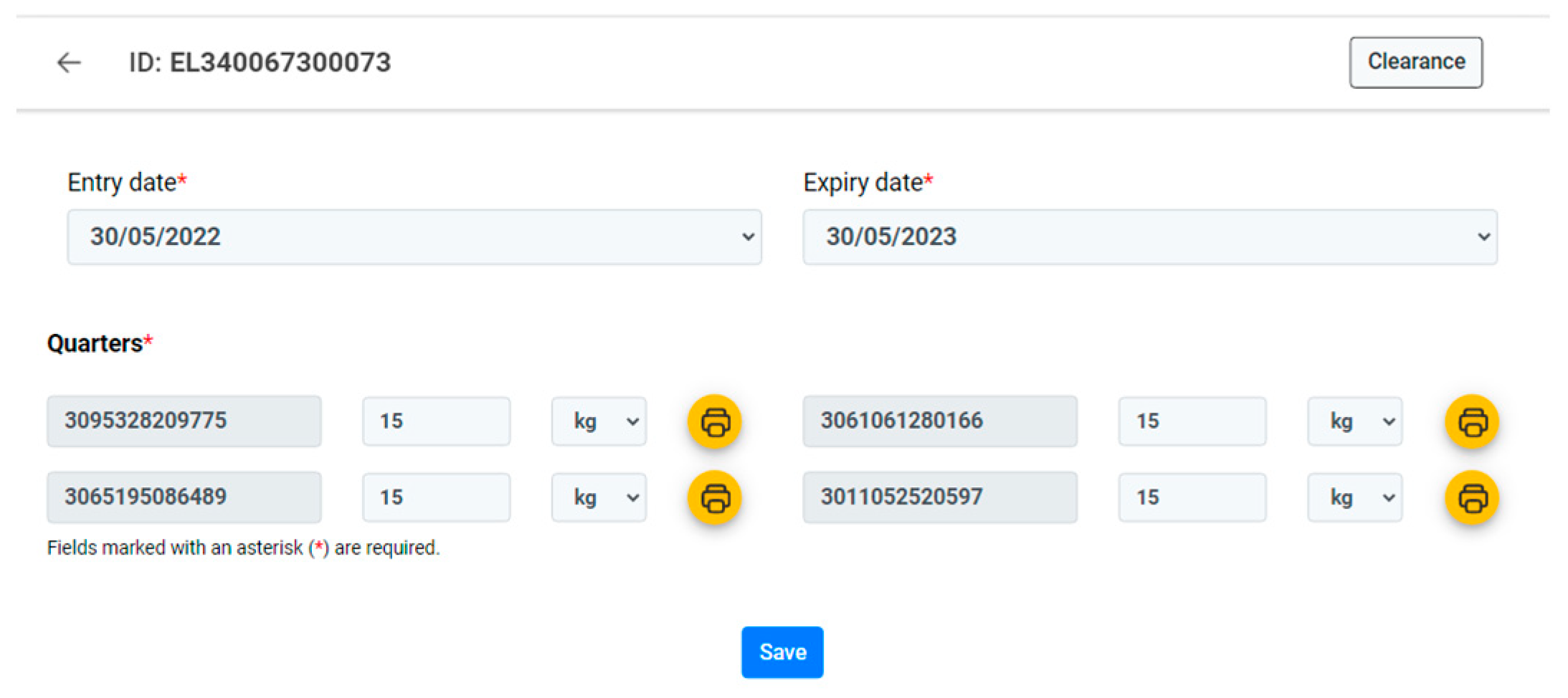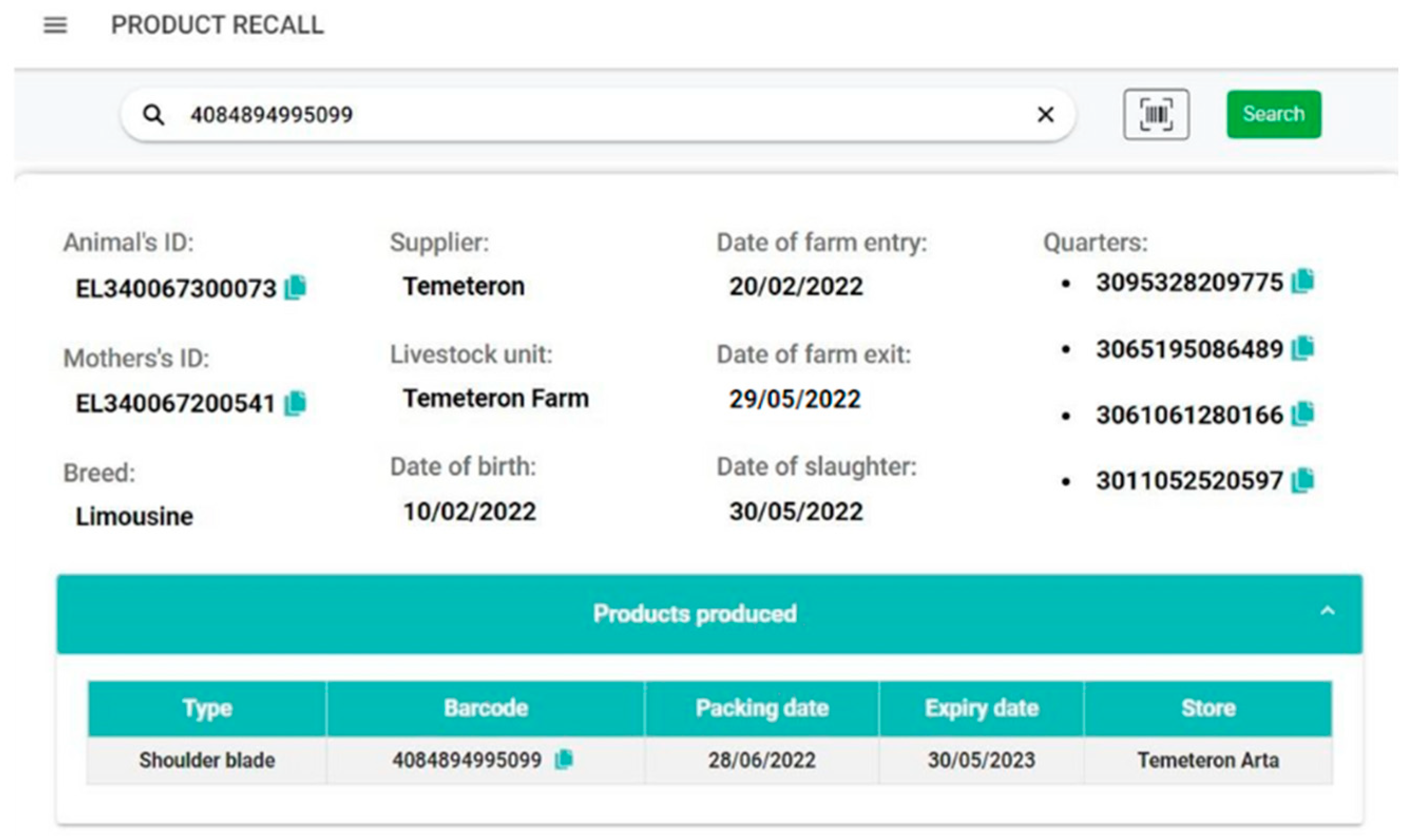Designing and Developing a Meat Traceability System: A Case Study for the Greek Meat Industry
Abstract
1. Introduction
2. Literature Review
2.1. Traceability
2.2. Research Studies on Traceability
2.2.1. Traceability as a Useful Tool
- Breadth (e.g., the amount of information it can collect);
- Depth (e.g., how far back or forward the system can detect the relevant information);
- Accuracy (e.g., the assurance of detecting a specific movement of a food item).
2.2.2. Traceability as a Differentiation and Added Value Tool
2.2.3. Traceability Implementation Issues
- Identifying traceable resource units (TRUs);
- Documenting transformations, e.g., links between TRUs;
- Recording the characteristics of TRUs;
- Communicating data between the operating units of the system.
3. Materials and Methods
3.1. System Architecture
3.2. System Requirements
3.3. Hardware Requirements
3.4. Software Requirements
3.4.1. Front-End Development
3.4.2. Back-End Development
4. Results
4.1. Animal Registration Stage
4.2. Animal Breeding Stage
4.3. Animal Slaughter Stage
4.4. Product Manufacturing Stage
4.5. Product Distribution and Recall Stage
4.6. Product Traceability by the Consumer
5. Discussion
5.1. Food Safety and Quality
5.2. Sustainability
5.3. Challenges and Feature Improvements
6. Conclusions
Author Contributions
Funding
Institutional Review Board Statement
Data Availability Statement
Acknowledgments
Conflicts of Interest
References
- Moysiadis, T.; Spanaki, K.; Kassahun, A.; Kläser, S.; Becker, N.; Alexiou, G.; Zotos, N.; Karali, I. AgriFood supply chain traceability: Data sharing in a farm-to-fork case. Benchmarking 2022. [Google Scholar] [CrossRef]
- Dima, A.; Arvaniti, E.; Stylios, C.; Kafetzopoulos, D.; Skalkos, D. Adapting Open Innovation Practices for the Creation of a Traceability System in a Meat-Producing Industry in Northwest Greece. Sustainability 2022, 14, 5111. [Google Scholar] [CrossRef]
- Aung, M.M.; Chang, Y.S. Traceability in a food supply chain: Safety and quality perspectives. Food Control 2014, 39, 172–184. [Google Scholar] [CrossRef]
- Qian, J.; Dai, B.; Wang, B.; Zha, Y.; Song, Q. Traceability in food processing: Problems, methods, and performance evaluations—A review. Crit. Rev. Food Sci. Nutr. 2022, 62, 679–692. [Google Scholar] [CrossRef] [PubMed]
- Karlsen Mari, K.; Olsen, P.; Anne-Marie Donnelly, K. Implementing traceability: Practical challenges at a mineral water bottling plant. Br. Food J. 2010, 112, 187–197. [Google Scholar] [CrossRef]
- EC Regulation No 178/2002 of the European Parliament and of the Council of 28 January 2002 laying down the general principles and requirements of food law, establishing the European Food Safety Authority and laying down procedures in matters of food safety. Off. J. Eur. Communities 2002, L 31, 1–24.
- Bosona, T.; Gebresenbet, G. Food traceability as an integral part of logistics management in food and agricultural supply chain. Food Control 2013, 33, 32–48. [Google Scholar] [CrossRef]
- Van der Vorst, J.G.; Da Silva, C.A.; Trienekens, J.H. Agro-Industrial Supply Chain Management: Concepts and Applications; Number 17 in Agricultural Management, Marketing and Finance Occasional Paper; FAO Agricultural Management, Marketing and Finance: Rome, Italy, 2007. [Google Scholar]
- Jose, A.; Shanmugam, P. Supply chain issues in SME food sector: A systematic review. J. Adv. Manag. Res. 2019, 17, 19–65. [Google Scholar] [CrossRef]
- Kafetzopoulos, D.; Stylios, C.D.; Skalkos, D. Managing Traceability in the Meat Processing Industry: Principles, Guidelines and Technologies. In Proceedings of the International Conference on Information and Communication Technologies for Sustainable Agri-Production and Environment, Thessaloniki, Greece, 24–27 September 2020. [Google Scholar]
- Girish, P.; Barbuddhe, S. Chapter 10—Meat traceability and certification in meat supply chain. In Meat Quality Analysis; Biswas, A.K., Mandal, P.K., Eds.; Academic Press: Cambridge, MA, USA, 2020; pp. 153–170. [Google Scholar] [CrossRef]
- Bennet, G.S. Food Identity Preservation and Traceability: Safer Grains; CRC Press: Boca Raton, FL, USA, 2009. [Google Scholar]
- Dabbene, F.; Gay, P.; Tortia, C. Traceability issues in food supply chain management: A review. Biosyst. Eng. 2014, 120, 65–80. [Google Scholar] [CrossRef]
- Red Meat Traceability Information Hub|Meat Livestock Australia—mla.com.au. Available online: https://www.mla.com.au/research-and-development/food-safety/red-meat-traceability-information-hub (accessed on 17 July 2023).
- Guruswamy, S.; Pojić, M.; Subramanian, J.; Mastilović, J.; Sarang, S.; Subbanagounder, A.; Stojanović, G.; Jeoti, V. Toward Better Food Security Using Concepts from Industry 5.0. Sensors 2022, 22, 8377. [Google Scholar] [CrossRef] [PubMed]
- Zhao, J.; Li, A.; Jin, X.; Pan, L. Technologies in individual animal identification and meat products traceability. Biotechnol. Biotechnol. Equip. 2020, 34, 48–57. [Google Scholar] [CrossRef]
- Echegaray, N.; Hassoun, A.; Jagtap, S.; Tetteh-Caesar, M.; Kumar, M.; Tomasevic, I.; Goksen, G.; Lorenzo, J.M. Meat 4.0: Principles and Applications of Industry 4.0 Technologies in the Meat Industry. Appl. Sci. 2022, 12, 6986. [Google Scholar] [CrossRef]
- Pigini, D.; Conti, M. NFC-Based Traceability in the Food Chain. Sustainability 2017, 9, 1910. [Google Scholar] [CrossRef]
- Yuan, C.; Wang, S.; Yu, X. The impact of food traceability system on consumer perceived value and purchase intention in China. Ind. Manag. Data Syst. 2020, 120, 810–824. [Google Scholar] [CrossRef]
- Qian, J.; Ruiz-Garcia, L.; Fan, B.; Robla Villalba, J.I.; McCarthy, U.; Zhang, B.; Yu, Q.; Wu, W. Food traceability system from governmental, corporate, and consumer perspectives in the European Union and China: A comparative review. Trends Food Sci. Technol. 2020, 99, 402–412. [Google Scholar] [CrossRef]
- Kassahun, A.; Hartog, R.; Sadowski, T.; Scholten, H.; Bartram, T.; Wolfert, S.; Beulens, A. Enabling chain-wide transparency in meat supply chains based on the EPCIS global standard and cloud-based services. Comput. Electron. Agric. 2014, 109, 179–190. [Google Scholar] [CrossRef]
- Charalampous, V.; Margariti, S.; Salmas, D.; Stylios, C.; Kafetzopoulos, D.; Skalkos, D. Design and develop cloud-based system for meat traceability. CEUR Workshop Proc. 2020, 2761, 475–484. [Google Scholar]
- Hebrok, M.; Heidenstrøm, N. Contextualising food waste prevention—Decisive moments within everyday practices. J. Clean. Prod. 2019, 210, 1435–1448. [Google Scholar] [CrossRef]
- Yiying, Z.; Yuanlong, R.; Fei, L.; Jing, S.; Song, L. Research on Meat Food Traceability System Based on RFID Technology. In Proceedings of the 2019 IEEE 3rd Information Technology, Networking, Electronic and Automation Control Conference (ITNEC), Chengdu, China, 15–17 March 2019; IEEE: Piscataway, NJ, USA, 2019; pp. 2172–2175. [Google Scholar] [CrossRef]
- Liu, X.; Yan, J.; Song, J. Blockchain-Based Food Traceability: A Dataflow Perspective. In Advances in E-Business Engineering for Ubiquitous Computing; Chao, K.M., Jiang, L., Hussain, O.K., Ma, S.P., Fei, X., Eds.; Springer International Publishing: Cham, Switzerland, 2020; pp. 421–431. [Google Scholar]
- Hao, Z.; Mao, D.; Zhang, B.; Zuo, M.; Zhao, Z. A Novel Visual Analysis Method of Food Safety Risk Traceability Based on Blockchain. Int. J. Environ. Res. Public Health 2020, 17, 2300. [Google Scholar] [CrossRef]
- Petropoulos, D.P. Analysis of the food and beverage industry in Greece (2009–2017). Adv. Manag. Appl. Econ. 2019, 9, 25–34. [Google Scholar]
- Awan, U.; Sroufe, R.; Bozan, K. Designing Value Chains for Industry 4.0 and a Circular Economy: A Review of the Literature. Sustainability 2022, 14, 7084. [Google Scholar] [CrossRef]
- Khan, M.; Parvaiz, G.S.; Dedahanov, A.T.; Abdurazzakov, O.S.; Rakhmonov, D.A. The Impact of Technologies of Traceability and Transparency in Supply Chains. Sustainability 2022, 14, 1633. [Google Scholar] [CrossRef]
- Hardt, M.J.; Flett, K.; Howell, C.J. Current Barriers to Large-scale Interoperability of Traceability Technology in the Seafood Sector. J. Food Sci. 2017, 82, A3–A12. [Google Scholar] [CrossRef]
- Olsen, P.; Borit, M. The components of a food traceability system. Trends Food Sci. Technol. 2018, 77, 143–149. [Google Scholar] [CrossRef]
- Harrison, M. EPC™ Information Service—Data Model and Queries; White paper, Auto-ID Centre for Manufacturing; University of Cambridge: Cambridge, UK, 2003. [Google Scholar]
- Verdenius, F. Using traceability systems to optimise business performance. In Improving Traceability in Food Processing and Distribution; Woodhead Publishing Ltd.: Sawston, UK, 2006; pp. 26–51. [Google Scholar] [CrossRef]
- Golan, E.; Krissoff, B.; Kuchler, F.; Calvin, L.; Nelson, K.E.; Price, G.K. Traceability in the U.S. Food Supply: Economic Theory and Industry Studies; Agricultural Economic Reports 33939; United States Department of Agriculture, Economic Research Service: Washington, DC, USA, 2004.
- Bertrand, J.; Wortmann, J.; Wijngaard, J. Production Control: A Structural and Design Oriented Approach; Manufacturing research and technology; Elsevier: Amsterdam, The Netherlands, 1990. [Google Scholar]
- Alfaro, J.A.; Rbade, L.A. Traceability as a strategic tool to improve inventory management: A case study in the food industry. Int. J. Prod. Econ. 2009, 118, 104–110. [Google Scholar] [CrossRef]
- Souza Monteiro, D.M.; Caswell, J.A. Traceability adoption at the farm level: An empirical analysis of the Portuguese pear industry. Food Policy 2009, 34, 94–101. [Google Scholar] [CrossRef]
- Hobbs, J. Liability and traceability in agri-food supply chains. Frontis 2006, 87–102. [Google Scholar] [CrossRef]
- Kafetzopoulos, D.; Margariti, S.; Stylios, C.; Arvaniti, E.; Kafetzopoulos, P. Managing the traceability system for food supply chain performance. Int. J. Product. Perform. Manag. 2023; ahead-of-print. [Google Scholar] [CrossRef]
- Chen, R.Y. An intelligent value stream-based approach to collaboration of food traceability cyber physical system by fog computing. Food Control 2017, 71, 124–136. [Google Scholar] [CrossRef]
- Yan, C.; Huanhuan, F.; Ablikim, B.; Zheng, G.; Xiaoshuan, Z.; Jun, L. Traceability information modeling and system implementation in Chinese domestic sheep meat supply chains. J. Food Process Eng. 2018, 41, e12864. [Google Scholar] [CrossRef]
- Balamurugan, S.; Ayyasamy, A.; Joseph, K.S. Enhanced petri nets for traceability of food management using internet of things. Peer-Peer Netw. Appl. 2021, 14, 30–43. [Google Scholar] [CrossRef]
- Bhatt, T.; Zhang, J.J. Food Product Tracing Technology Capabilities and Interoperability. J. Food Sci. 2013, 78, B28–B33. [Google Scholar] [CrossRef]
- Bhatt, T.; Cusack, C.; Dent, B.; Gooch, M.; Jones, D.; Newsome, R.; Stitzinger, J.; Sylvia, G.; Zhang, J. Project to Develop an Interoperable Seafood Traceability Technology Architecture: Issues Brief. Compr. Rev. Food Sci. Food Saf. 2016, 15, 392–429. [Google Scholar] [CrossRef]
- Zhang, S.; Liao, J.; Wu, S.; Zhong, J.; Xue, X. A Traceability Public Service Cloud Platform Incorporating IDcode System and Colorful QR Code Technology for Important Product. Math. Probl. Eng. 2021, 2021, 5535535. [Google Scholar] [CrossRef]
- Rahman, L.F.; Alam, L.; Marufuzzaman, M.; Sumaila, U.R. Traceability of Sustainability and Safety in Fishery Supply Chain Management Systems Using Radio Frequency Identification Technology. Foods 2021, 10, 2265. [Google Scholar] [CrossRef]
- Hallak, J.C.; Tacsir, A. Traceability systems as a differentiation tool in agri-food value chains: A framework for public policies in Latin America. J. Agribus. Dev. Emerg. Econ. 2022, 12, 673–688. [Google Scholar] [CrossRef]
- Bougdira, A.; Ahaitouf, A.; Akharraz, I. Conceptual framework for general traceability solution: Description and bases. J. Model. Manag. 2019, 15, 509–530. [Google Scholar] [CrossRef]
- Whittaker, B. InfinityQS. Three Essential Tools for Traceability and Food Safety in Manufacturing. 2020. Available online: https://www.infinityqs.com/blog/june-2018/three-essential-tools-for-traceability-and-food-sa (accessed on 11 June 2023).
- Alfian, G.; Rhee, J.; Ahn, H.; Lee, J.; Farooq, U.; Ijaz, M.F.; Syaekhoni, M.A. Integration of RFID, wireless sensor networks, and data mining in an e-pedigree food traceability system. J. Food Eng. 2017, 212, 65–75. [Google Scholar] [CrossRef]
- Bai, H.; Zhou, G.; Hu, Y.; Sun, A.; Xu, X.; Liu, X.; Lu, C. Traceability technologies for farm animals and their products in China. Food Control 2017, 79, 35–43. [Google Scholar] [CrossRef]
- Mutua, F.; Kihara, A.; Rogena, J.; Ngwili, N.; Aboge, G.; Wabacha, J.; Bett, B. Piloting a livestock identification and traceability system in the northern Tanzania–Narok–Nairobi trade route. Trop. Anim. Health Prod. 2018, 50, 299–308. [Google Scholar] [CrossRef]
- Yu, Z.; Jung, D.; Park, S.; Hu, Y.; Huang, K.; Rasco, B.A.; Wang, S.; Ronholm, J.; Lu, X.; Chen, J. Smart traceability for food safety. Crit. Rev. Food Sci. Nutr. 2022, 62, 905–916. [Google Scholar] [CrossRef]
- Voulodimos, A.S.; Patrikakis, C.Z.; Sideridis, A.B.; Ntafis, V.A.; Xylouri, E.M. A complete farm management system based on animal identification using RFID technology. Comput. Electron. Agric. 2010, 70, 380–388. [Google Scholar] [CrossRef]
- Feng, J.; Fu, Z.; Wang, Z.; Xu, M.; Zhang, X. Development and evaluation on a RFID-based traceability system for cattle/beef quality safety in China. Food Control 2013, 31, 314–325. [Google Scholar] [CrossRef]
- Liang, W.; Cao, J.; Fan, Y.; Zhu, K.; Dai, Q. Modeling and Implementation of Cattle/Beef Supply Chain Traceability Using a Distributed RFID-Based Framework in China. PLoS ONE 2015, 10, 1–17. [Google Scholar] [CrossRef] [PubMed]
- Shi, X.; An, X.; Zhao, Q.; Liu, H.; Xia, L.; Sun, X.; Guo, Y. State-of-the-Art Internet of Things in Protected Agriculture. Sensors 2019, 19, 1833. [Google Scholar] [CrossRef]
- Alfian, G.; Syafrudin, M.; Fitriyani, N.L.; Rhee, J.; Ma’arif, M.R.; Riadi, I. Traceability system using IoT and forecasting model for food supply chain. In Proceedings of the 2020 International Conference on Decision Aid Sciences and Application (DASA), Sakheer, Bahrain, 8–9 November 2020; pp. 903–907. [Google Scholar] [CrossRef]
- Khan, S.; Parkinson, S.; Qin, Y. Fog computing security: A review of current applications and security solutions. J. Cloud Comput. 2017, 6, 19. [Google Scholar] [CrossRef]
- Bergier, I.; Papa, M.; Silva, R.; Santos, P.M. Cloud/edge computing for compliance in the Brazilian livestock supply chain. Sci. Total Environ. 2021, 761, 143276. [Google Scholar] [CrossRef]
- Azanha, A.; Argoud, A.R.; de Camargo Junior, J.; Antoniolli, P. Agile project management with Scrum: A case study of a Brazilian pharmaceutical company IT project. Int. J. Manag. Proj. Bus. 2017, 10, 121–142. [Google Scholar] [CrossRef]
- Tessem, B. The customer effect in agile system development projects. A process tracing case study. Procedia Comput. Sci. 2017, 121, 244–251. [Google Scholar] [CrossRef]
- Hellenic Food Authority (EFET). Traceability in Food Businesses. 2015. Available online: https://www.efet.gr/files/F29917_ixnilasimotita.pdf (accessed on 11 June 2023).
- Guan, S.; Hu, W.; Zhou, H. Front-end and Back-end Separation—React Based Framework for Networked Remote Control Laboratory. In Proceedings of the 2018 37th Chinese Control Conference (CCC), Wuhan, China, 25–27 July 2018; IEEE: Piscataway, NJ, USA, 2018; pp. 6314–6319. [Google Scholar] [CrossRef]
- de Andrade, P.R.M.; Frota, O.; Silva, F.; Albuquerque, A.; Silveira, R. Cross Platform App: A Comparative Study. J. Comput. Sci. Technol. 2015, 7. [Google Scholar] [CrossRef]
- Sahani, A.K.; Singh, P.; Jeyamani, V. Web Development Using Angular: A Case Study. J. Inform. Electr. Electron. Eng. (JIEEE) 2020, 1, 1–7. [Google Scholar] [CrossRef]
- Cincovic, J.; Delcev, S.; Draskovic, D. Architecture of web applications based on Angular Framework: A Case Study. Methodology 2019, 7, 7. [Google Scholar]
- Guo, D.; Onstein, E. State-of-the-Art Geospatial Information Processing in NoSQL Databases. ISPRS Int. J. Geo-Inf. 2020, 9, 331. [Google Scholar] [CrossRef]
- EC Directive 98/58/EC of 20 July 1998 concerning the protection of animals kept for farming purposes. Off. J. Eur. Community 1998, 8, 221–223.
- EC Regulation No 1/2005 of 22 December 2004 on the protection of animals during transport and related operations and amending Directives 64/432/EEC and 93/119/EC and Regulation (EC) No 1255/97. Off. J. Eur. Union 2005, L 3, 1–44.
- EC Regulation No 1099/2009 of 24 September 2009 on the protection of animals at the time of killing. Off. J. Eur. Union 2009, 303, 1–30.
- Diogo, M.; Cabral, B.; Bernardino, J. Consistency Models of NoSQL Databases. Future Internet 2019, 11, 43. [Google Scholar] [CrossRef]
- EC Directive 2004/83/EC of 29 April 2004 on Minimum Standards for the Qualification and Status of Third Country Nationals or Stateless Persons as Refugees or as Persons Who Otherwise Need International Protection and the Content of the Protection Granted, 30 September 2004. Off. J. Eur. Union 2004, L 304, 12–23. Available online: https://www.refworld.org/docid/4157e75e4.html (accessed on 13 July 2023).
- EC Regulation No 10/2011 of 14 January 2011 on plastic materials and articles intended to come into contact with food Text with EEA relevance. Off. J. Eur. Union 2011, 45, 42–130.
- EC Regulation No 1935/2004 of 27 October 2004 on materials and articles intended to come into contact with food and repealing Directives 80/590/EEC and 89/109/EEC. Off. J. Eur. Union 2005, 50, 4–17.
- EC Regulation No 2023/2006 of 22 December 2006 on good manufacturing practice for materials and articles intended to come into contact with food (Text with EEA relevance). Off. J. Eur. Union 2006, 50, 75–78.
- EUKREAS—The Project. Available online: https://www.eukreas.eu/the-project/ (accessed on 13 July 2023).
- Ko-Meat it—Ko-Meat.eu. Available online: https://www.ko-meat.eu/ (accessed on 13 July 2023).
- Haji, M.; Kerbache, L.; Muhammad, M.; Al-Ansari, T. Roles of Technology in Improving Perishable Food Supply Chains. Logistics 2020, 4, 33. [Google Scholar] [CrossRef]
- Astill, J.; Dara, R.A.; Campbell, M.; Farber, J.M.; Fraser, E.D.; Sharif, S.; Yada, R.Y. Transparency in food supply chains: A review of enabling technology solutions. Trends Food Sci. Technol. 2019, 91, 240–247. [Google Scholar] [CrossRef]
- Gosnell, H.; Emard, K.; Hyde, E. Taking Stock of Social Sustainability and the U.S. Beef Industry. Sustainability 2021, 13, 11860. [Google Scholar] [CrossRef]
- Kamble, S.S.; Gunasekaran, A.; Gawankar, S.A. Achieving sustainable performance in a data-driven agriculture supply chain: A review for research and applications. Int. J. Prod. Econ. 2020, 219, 179–194. [Google Scholar] [CrossRef]
- Teixeira, A.; Rodrigues, S. Consumer perceptions towards healthier meat products. Curr. Opin. Food Sci. 2021, 38, 147–154. [Google Scholar] [CrossRef]








| Hardware | Description | Role |
|---|---|---|
| Zebra Thermal Printer | Printing of unique QR and barcodes (GS1 Data bar) | Printing QR and barcodes |
| Zebra Barcode Scanner | Decode the data contained in the barcode | Reading barcodes |
| Mobile and desktop devices | A complete recording of the animal’s available information in real time through the software platform | Information acquisition/transmission/tracking/tracing |
| Server | Store, retrieve, and process data in a remote cloud-based database | Data processing and management |
Disclaimer/Publisher’s Note: The statements, opinions and data contained in all publications are solely those of the individual author(s) and contributor(s) and not of MDPI and/or the editor(s). MDPI and/or the editor(s) disclaim responsibility for any injury to people or property resulting from any ideas, methods, instructions or products referred to in the content. |
© 2023 by the authors. Licensee MDPI, Basel, Switzerland. This article is an open access article distributed under the terms and conditions of the Creative Commons Attribution (CC BY) license (https://creativecommons.org/licenses/by/4.0/).
Share and Cite
Botilias, G.-P.; Margariti, S.V.; Besarat, J.; Salmas, D.; Pachoulas, G.; Stylios, C.; Skalkos, D. Designing and Developing a Meat Traceability System: A Case Study for the Greek Meat Industry. Sustainability 2023, 15, 12162. https://doi.org/10.3390/su151612162
Botilias G-P, Margariti SV, Besarat J, Salmas D, Pachoulas G, Stylios C, Skalkos D. Designing and Developing a Meat Traceability System: A Case Study for the Greek Meat Industry. Sustainability. 2023; 15(16):12162. https://doi.org/10.3390/su151612162
Chicago/Turabian StyleBotilias, Giannis-Panagiotis, Spiridoula V. Margariti, Jeries Besarat, Dimitrios Salmas, George Pachoulas, Chrysostomos Stylios, and Dimitris Skalkos. 2023. "Designing and Developing a Meat Traceability System: A Case Study for the Greek Meat Industry" Sustainability 15, no. 16: 12162. https://doi.org/10.3390/su151612162
APA StyleBotilias, G.-P., Margariti, S. V., Besarat, J., Salmas, D., Pachoulas, G., Stylios, C., & Skalkos, D. (2023). Designing and Developing a Meat Traceability System: A Case Study for the Greek Meat Industry. Sustainability, 15(16), 12162. https://doi.org/10.3390/su151612162








